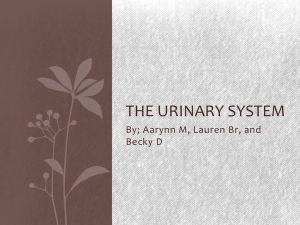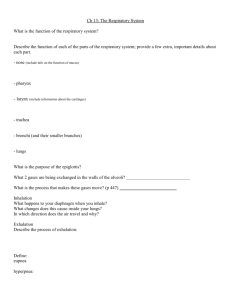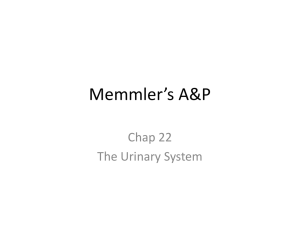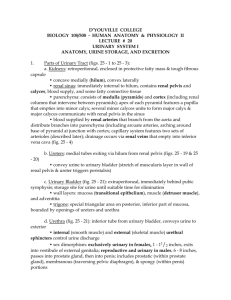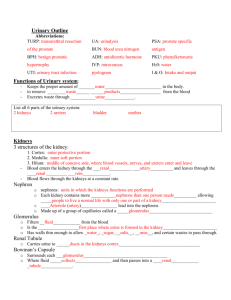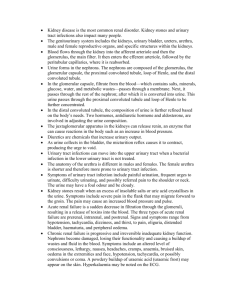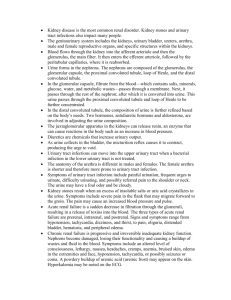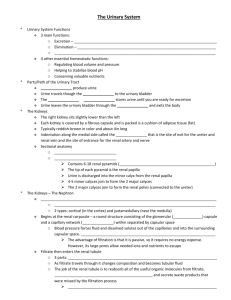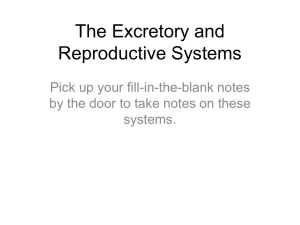Chapter 15 Outline - Navarro College Shortcuts
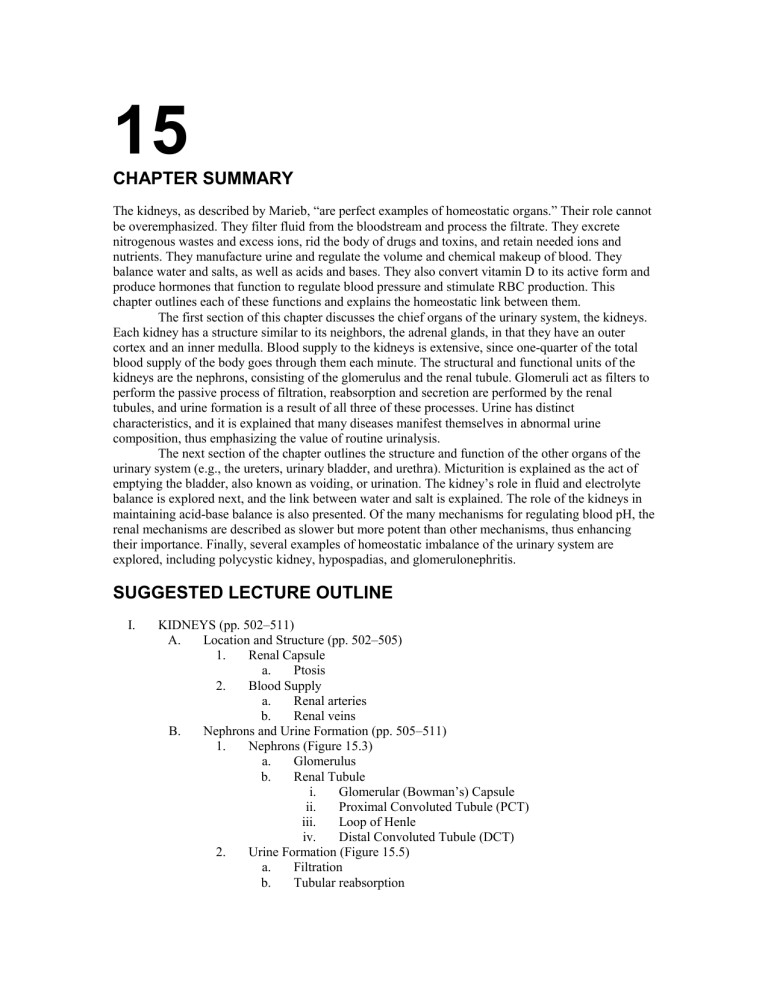
15
The Urinary System
CHAPTER SUMMARY
The kidneys, as described by Marieb, “are perfect examples of homeostatic organs.” Their role cannot be overemphasized. They filter fluid from the bloodstream and process the filtrate. They excrete nitrogenous wastes and excess ions, rid the body of drugs and toxins, and retain needed ions and nutrients. They manufacture urine and regulate the volume and chemical makeup of blood. They balance water and salts, as well as acids and bases. They also convert vitamin D to its active form and produce hormones that function to regulate blood pressure and stimulate RBC production. This chapter outlines each of these functions and explains the homeostatic link between them.
The first section of this chapter discusses the chief organs of the urinary system, the kidneys.
Each kidney has a structure similar to its neighbors, the adrenal glands, in that they have an outer cortex and an inner medulla. Blood supply to the kidneys is extensive, since one-quarter of the total blood supply of the body goes through them each minute. The structural and functional units of the kidneys are the nephrons, consisting of the glomerulus and the renal tubule. Glomeruli act as filters to perform the passive process of filtration, reabsorption and secretion are performed by the renal tubules, and urine formation is a result of all three of these processes. Urine has distinct characteristics, and it is explained that many diseases manifest themselves in abnormal urine composition, thus emphasizing the value of routine urinalysis.
The next section of the chapter outlines the structure and function of the other organs of the urinary system (e.g., the ureters, urinary bladder, and urethra). Micturition is explained as the act of emptying the bladder, also known as voiding, or urination. The kidney’s role in fluid and electrolyte balance is explored next, and the link between water and salt is explained. The role of the kidneys in maintaining acid-base balance is also presented. Of the many mechanisms for regulating blood pH, the renal mechanisms are described as slower but more potent than other mechanisms, thus enhancing their importance. Finally, several examples of homeostatic imbalance of the urinary system are explored, including polycystic kidney, hypospadias, and glomerulonephritis.
SUGGESTED LECTURE OUTLINE
I.
KIDNEYS (pp. 502–511)
A.
Location and Structure (pp. 502–505)
1.
Renal Capsule a.
Ptosis
2.
Blood Supply a.
Renal arteries b.
Renal veins
B.
Nephrons and Urine Formation (pp. 505–511)
1.
Nephrons (Figure 15.3) a.
Glomerulus b.
Renal Tubule i.
Glomerular (Bowman’s) Capsule ii.
Proximal Convoluted Tubule (PCT) iii.
Loop of Henle iv.
Distal Convoluted Tubule (DCT)
2.
Urine Formation (Figure 15.5) a.
Filtration b.
Tubular reabsorption
i.
Nitrogenous waste products c.
Tubular secretion
3.
Characteristics of Urine a.
Specific gravity
II.
URETERS, URINARY BLADDER, AND URETHRA (pp. 512–514)
A.
Ureters (p. 512)
1.
Renal calculi
B.
Urinary Bladder (pp. 512–513)
C.
Urethra (p. 513)
1.
Internal Sphincter
2.
External Sphincter
D.
Micturition (p. 514)
1.
Incontinence
2.
Urinary Retention
III.
FLUID, ELECTROLYTE, AND ACID-BASE BALANCE (pp. 514–520)
A.
Maintaining Water Electrolyte Balance of Blood (pp. 514–518)
1.
Body Fluids and Fluid Compartments a.
Intracellular fluid b.
Extracellular fluid
2.
The Link Between Water and Salt a.
Electrolyte balance b.
Antidiuretic hormone (ADH) c.
Aldosterone d.
Renin-angiotensin mechanism
B.
Maintaining Acid-Base Balance of Blood (pp. 518–520)
1.
Blood Buffers a.
Acidosis b.
Alkalosis c.
Bicarbonate buffer system
2.
Respiratory System Controls a.
Carbonic anhydrase
3.
Renal Mechanisms
IV.
DEVELOPMENTAL ASPECTS OF THE URINARY SYSTEM (pp. 520–521)
A.
Polycystic kidneys
B.
Hypospadias
Glomerulonephritis
